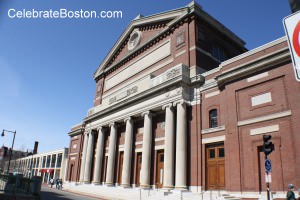Boston Symphony Orchestra
The Boston Symphony Orchestra was borne out of the vision of amateur musician and philanthropist, Henry Lee Higginson. His longstanding vision for a great and permanent orchestra in Boston eventually became a reality in the spring of 1881. The Orchestra's inaugural concert took place on October 22, 1881. Today, the organization is comprised of the Boston Symphony Orchestra, Boston Pops Orchestra, Boston Symphony Chamber Players, as well groups that sponsor many community and youth outreach programs. The Orchestra is considered one of the greatest in the world.
Since its first concert, the Boston Symphony Orchestra, or BSO as it also known, has performed throughout the United States, and has also traveled to South America, Europe, and Asia, including China and Japan. The Orchestra's reach extends greatly beyond its physical concerts, with millions of people listening through recordings, the radio, and on television.

Some of the milestones that the Orchestra has achieved over the years includes moving to Symphony Hall on October 15, 1900 from the old Music Hall (today's Orpheum Theatre). The first transcontinental trip occurred in 1915 to the Panama-Pacific Exposition in San Francisco, where they played thirteen concerts. In 1917, the Orchestra began recording its work, with live broadcasts starting in 1926.
In 1936, concerts were held in the Berkshire Hills of Massachusetts under the guidance of Music Director Serge Koussevitzky. The following summer, Koussevitzky and his players first began their annual summer migration to the Berkshires. The Orchestra's summer season at Tanglewood is regarded as one of the world's most important music festivals. Also., the Orchestra sponsors the Tanglewood Music Center school each summer. The Center was founded in 1940, and was the realization of founder Henry Lee Higginson's secondary dream of a "good honest school for musicians," a passion also shared by Serge Koussevitzky. The Music Center is a world-renowned training place for young musicians, conductors, composers, and vocalists.
Another aspect of Higginson's original vision was to perform "concerts of a lighter kind of music," with the result being today's Boston Pops Orchestra. Today, the Pops set an international standard by peforming unique arrangements of pop and classical music. This separate sub-orchestra began in July, 1885, when some of the musicians of the main Orchestra gave their first "Promenade" concerts. These springtime performances, first called "Popular" concerts, and then just "Pops," soon became a tradition. 1929 saw the inauguration of the free Esplanade Concerts in Boston at along the Charles River. Arthur Fiedler, a member of the main Boston Symphony Orchestra, had introduced the Esplanade concerts, and became conductor of the Pops in 1930. Fiedler held this position for an amazing fifty years, handing the baton over to John Williams in 1979.
James Levine was the Orchestra's first American-born Music Director (2004). Under his tenure, the Orchestra has presented a wide range of programs from orchestral, operatic and choral classics, to modern works and even brand-new compositions by some of today's most important composers. Levine accompanied the BSO on their first European tour, where they performed in Paris, Essen, the Schleswig-Holstein Festival in Hamburg, the Berlin Festival, the Lucerne Festival and at the BBC Proms in London.
Performing more than 250 concerts each year, the Boston Symphony Orchestra can be considered one of the greatest Orchestras in the world. Enjoy a winter concert at Boston Symphony Hall, or head west to Tanglewood and attend the famous music festival during summer.
Contact Information & Address:
Boston Symphony Orchestra (Symphony Hall)
301 Massachusetts Avenue
Boston, MA 02115
617.266.1492 (Information)
888.266.1200 (Tickets)
bso.org
